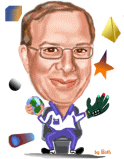| Web3D 2002 it Was A Cool Conference | |
| in Tempe Arizona | |
Dateline: March 14, 2002
The Web3D Symposium recently held in Tempe Arizona, turned out to be a totally cool conference! In spite of the recent economic downturn and fears of travel around 120 people enjoyed a terrific conference. The conference consisted of several major elements, presentation of technical papers, tutorials, an art show, keynote speakers, and a mini version of the "roundup" we call Web3D Unplugged.
The technical papers were probably the best collection of papers in the history of the symposium. Paper's chair Matt Beitler put together a terrific collection of papers. The best paper went to Martin Isenburg and Jack Snoeyink from UNC Chapel Hill entitled "Coding Polygonal Meshes as Compressable ASCII." It's a compression system that encodes data using ASCII resulting in a file that remains editable, cool trick! You can purchase copies of the Web3D Symposium containing the papers and a summary of the art show from ACM.
Speaking of the Art Show, Kathy Rae Huffman and Karel Dudesek organized, within a very short time period, a robust art show that demonstrates the tremendous depth of art out there. The art show was presented by demonstrating each piece, projected on a large screen, with commentary by Kathy or Karel. The best part of the art show is that you can still look at it online at web3dart.org.
The tutorials consisted of well run collections about X3D, Adobe Atmosphere, XJ3D (X3D viewer) and a terrific overview of SVG, the Scalable Vector Graphics recommendation of the W3C.
Another highlight of the symposium was a series of three keynote speeches. Peter Ryce from Macromedia talked about Shockwave 3D, and primarily made the point that for 3D on the web to succeed it needs a business case. Shockwave 3D models are created using Director. The actual models are usually created using a high end modeling package such as 3DS Max, or Maya. You then add interactivity using the tools in Director. One example Ryce talked about was a training program Macromedia implemented for Cisco on the for the configuration of high-end routers. The use of 3D models to demonstrate and train people on configurations of these expensive routers is saving Cisco many hundreds of thousands of dollars.
Mike Kaplan from Adobe and Bruce Damer from DigitalSpace presented Atmosphere. Atmosphere is a product suite to create multi-user collaborative 3D worlds. There are 3 components to Atmosphere, a server to manage the shared world, a player to display the world on the client's computer, and a builder to create the shared world. Atmosphere has been available as an alpha or beta for quite a while, and it always seemed interesting, however it was a mystery (to me) as to how they would actually make money. According to Kaplan the strategy is very simple, Adobe sells authoring tools and they will sell a version of the Atmosphere Builder. However they will also perpetually give away an older, one version behind, of Builder. Adobe gives away the Server, including source code, and the player. Adobe will host your shared world if you like, however you can set up your own server. Most interesting was the Builder. Adobe is attempting to create an easy to use, yet robust, 3D world builder tool. It will be a first if they succeed. Most 3D tools are extremely complex and hard to use. In addition Adobe has a plug-in architecture in which you can use Viewpoint models or physics simulation capabilities from the Havok physics engine, also included free! Bruce Damer of "Avatar" fame and founder of the Contact Consortium, is now working with Adobe to create a viable and robust community. Adobe couldn't have picked a better person to work with. Of course the verdict on whether there are enough compelling uses of 3D shared worlds to support a product is still out. Adobe is making a full court press with this product and once it actually goes to market should prove to be extremely interesting.
Last but certainly not least, the prime keynote was a talk by Ben Shneiderman, professor at the University of Maryland in College Park titled "3D or Not 3D: When and Why Does it Work?". Shneiderman gave the gathering of 3D fanatics a needed dose of reality and emphasized the need for good science to measure the effectiveness of 3D. Shneiderman's slides are available from the presentations section of the Human-Computer Interface Lab at U of MD.
Instead of a full blow "Web3D Roundup" which was not possible this year. Michael Wagner organized a "Web3D Unplugged" event, which I had the pleasure of being the Master of Ceremonies, and a collection of a dozen demonstration took place. Each presenter brought there own laptop and had 5 minutes to present their work, while I subjected them to a variety of wisecracks. A good time was had by all, and prizes, Swift3D, were awarded to the best and worst presentation. VCOM3D won for demonstrating their Signing Avatar authoring system.
The relatively small nature of the conference turned out to be a positive element as people were able to talk easily and to spend quality time with each other. The venue, Tempe Arizona, was totally fabulous and the weather cooperated as well. All in all it was a terrific show and marks another milestone in Web3D history.

